Murree
| Murree مری | |
|---|---|
| Municipality | |
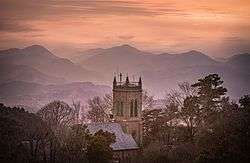     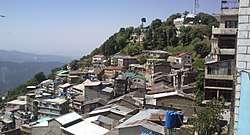 Clockwise from top: Sunset over Murree's Holy Trinity Church, Ayubia National Park, General Post Office, view of valley and Mall Road, colonial-era Mall in central Murree, Patriata's Gondola Lift | |
| Nickname(s): The Depot (British India), The White City | |
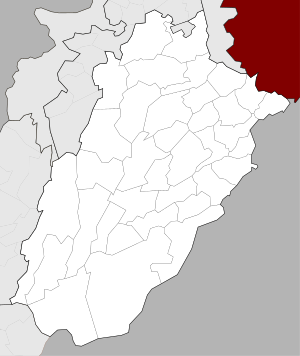 Murree Location within Pakistan  Murree Murree (Pakistan) | |
| Coordinates: 33°54′15″N 73°23′25″E / 33.90417°N 73.39028°ECoordinates: 33°54′15″N 73°23′25″E / 33.90417°N 73.39028°E | |
| Country |
|
| Province | Punjab |
| District | Rawalpindi |
| Government | |
| • MNA (NA-57) | Sadaqat Ali Abbasi (Pakistan tehreek-e-insaf) |
| Elevation | 2,291.2 m (7,517.1 ft) |
| Population | |
| • Total | 233,471[1] |
| Time zone | UTC+5 (PST) |
| Union Councils | 8 |
Murree (Punjabi, Urdu: مری, marī, meaning "apex"[2]) is a mountain resort town, located in the Galyat region of the Pir Panjal Range, within the Rawalpindi District of Punjab, Pakistan. It forms the outskirts of the Islamabad-Rawalpindi metropolitan area, and is about 30 km (19 mi) northeast of Islamabad. It has average altitude of 2,291 metres (7,516 ft).[3]
Murree was founded in 1851 as a sanatorium for British troops. The permanent town of Murree was constructed in 1853 and the church was sanctified shortly thereafter. One main road was established, commonly referred to even in modern times, as the mall. Murree was the summer headquarters of the colonial Punjab Government until 1876 when it was moved to Shimla.[4]
Murree became a popular tourist station for British within the British India, several prominent Englishmen were born here including Bruce Bairnsfather, Francis Younghusband and Reginald Dyer.[5] During colonial era access to commercial establishments was restricted for non-Europeans including the Lawrence College. In 1901, the population of the town was officially 1,844, although if summer visitors had been included this could have been as high as 10,000.[4]
Since the Independence of Pakistan in 1947, Murree has retained its position as a popular hill station, noted for its pleasant summers. A large number of tourists visit the town from the Islamabad-Rawalpindi area.[6] The town also serves as a transit point for tourist's visiting Azad Kashmir and Abbottabad.[7][8] The town is noted for its Tudorbethan and neo-gothic architecture. The Government of Pakistan owns a summer retreat in Murree, where foreign dignitaries including heads of state often visit.[9][10]
History
Murree or Marhee as it was then called, was first identified as a potential hill station by Major James Abbott (Indian Army officer) in 1847.[lower-alpha 1]
The town's early development was in 1851 by President of the Punjab Administrative Board, Sir Henry Lawrence.[lower-alpha 1] It was originally established as a sanatorium for British troops garrisoned on the Afghan frontier.[4] Officially, the municipality was created in 1850.[11]
The permanent town of Murree was constructed at Sunnybank in 1853. The church was sanctified in May 1857, and the main road, Jinnah Road, originally known as Mall Road and still commonly referred to as "The Mall"), was built. The most significant commercial establishments, the Post Office, general merchants with European goods, tailors and a millinery, were established opposite the church. Until 1947, access to Mall Road was restricted for "natives" (non-Europeans).
In the summer of 1857, a rebellion against the British broke out. The local tribes of Murree and Hazara, including the Dhund Abbasis and others, attacked the depleted British Army garrison in Murree; however, the tribes were ultimately overcome by the British and capitulated.[12] From 1873 to 1875, Murree was the summer headquarters of the Punjab local government;[11] after 1876 the headquarters were moved to Shimla.[4]
The railway connection with Lahore, the capital of the Punjab Province, via Rawalpindi, made Murree a popular resort for Punjab officials, and the villas and other houses erected for the accommodation of English families gave it a European aspect. The houses crowned the summit and sides of an irregular ridge, the neighbouring hills were covered during the summer with encampments of British troops, while the station itself was filled with European visitors from the plains and travellers to Kashmir. It was connected with Rawalpindi by a service tangas.[11]
It was described in the Gazetteer of Rawalpindi District, 1893–94 as follows:
The sanatorium of Murree lies in north latitude 33° 54′ 30″ and east longitude 73° 26′ 30″, at an elevation of 7,517 feet (2,291 m) above sea level, and contained a standing population of 1,768 inhabitants, which was, however, enormously increased during the [May–November] season by the influx of visitors and their attendant servants and shopkeepers. It is the most accessible hill station in the Punjab, being distant from Rawalpindi only a five hours' journey by tonga dak. Magnificent views are to be obtained in the spring and autumn of the snow crowned mountains of Kashmir; and gorgeous sunset and cloud effects seen daily during the rains [July–August]. Part of the station, especially the Kashmir end, are also well wooded and pretty.
In 1901 the permanent population of the town was 1,844; if summer visitors had been included this could have been as high as 10,000.[4]
Climate
Murree features a subtropical highland climate (Cwb) under the Köppen climate classification. It is situated in the outer Himalayas, retaining high altitude. This type of area has cold, snowy winters, relatively cool summers with drastically escalated rain, in relation with lower altitudes, and frequent fog. Precipitation is received year round, with two maxima, first one during winter and second one at summer, July–August. Total mean precipitation annually is 1,789 mm (70.4 in).[13]murree receives around 62.6 inches of snow per year according to a 13-year data.
| Climate data for Muree | |||||||||||||
|---|---|---|---|---|---|---|---|---|---|---|---|---|---|
| Month | Jan | Feb | Mar | Apr | May | Jun | Jul | Aug | Sep | Oct | Nov | Dec | Year |
| Record high °C (°F) | 17.2 (63) |
19.8 (67.6) |
23.0 (73.4) |
26.0 (78.8) |
32.0 (89.6) |
32.2 (90) |
31.7 (89.1) |
27.2 (81) |
25.6 (78.1) |
25.0 (77) |
22.3 (72.1) |
21.1 (70) |
32.2 (90) |
| Average high °C (°F) | 7.2 (45) |
7.5 (45.5) |
11.6 (52.9) |
17.2 (63) |
21.7 (71.1) |
25.1 (77.2) |
22.4 (72.3) |
21.4 (70.5) |
20.9 (69.6) |
18.6 (65.5) |
14.5 (58.1) |
10.2 (50.4) |
16.5 (61.8) |
| Daily mean °C (°F) | 3.7 (38.7) |
4.0 (39.2) |
8.0 (46.4) |
13.2 (55.8) |
17.3 (63.1) |
20.6 (69.1) |
19.1 (66.4) |
18.4 (65.1) |
17.2 (63) |
14.3 (57.7) |
10.3 (50.5) |
6.3 (43.3) |
12.7 (54.9) |
| Average low °C (°F) | 0.1 (32.2) |
0.5 (32.9) |
4.3 (39.7) |
9.1 (48.4) |
12.8 (55) |
16.1 (61) |
15.7 (60.3) |
15.4 (59.7) |
13.4 (56.1) |
10.1 (50.2) |
6.2 (43.2) |
2.4 (36.3) |
8.8 (47.9) |
| Record low °C (°F) | −8.4 (16.9) |
−10.6 (12.9) |
−7 (19) |
−3.3 (26.1) |
0.6 (33.1) |
3.6 (38.5) |
8.9 (48) |
10.0 (50) |
6.0 (42.8) |
1.1 (34) |
−3.3 (26.1) |
−10.5 (13.1) |
−10.6 (12.9) |
| Average precipitation mm (inches) | 126.5 (4.98) |
145.0 (5.709) |
176.8 (6.961) |
133.0 (5.236) |
91.9 (3.618) |
130.3 (5.13) |
339.3 (13.358) |
326.3 (12.846) |
146.5 (5.768) |
70.2 (2.764) |
32.5 (1.28) |
70.3 (2.768) |
1,788.6 (70.418) |
| Source: NOAA (1961–1990)[14] | |||||||||||||
Ecology
A variety of rare animal species can be found in Murree, including the leopard, which inhabits the neighboring Galiyat region. Common animals include the rhesus monkey, wild boar, foxes and various species of birds, including the cheer pheasant and kalij pheasant. Murree gives its name to the Murree vole, a rodent species endemic to Pakistan. Murree's climate is unpredictable. It can change any time.[15]
Famous personalities
- Shahid Khakan Abbasi, former Prime Minister of Pakistan
- Ansar Abbasi, journalist and socially conservative commentator
- Muztar Abbasi, scholar
- Zafar Mahmood Abbasi, Chief of the Naval Staff (CNS) of Pakistan Navy
- Mehtab Abbasi, politician
- khaqan Abbasi, politician
- Marriyum Aurangzeb, politician
- Kashif Abbasi, journalist, television talk show host and anchorperson
- Raja Ashfaq Sarwar, politician
- Sadia Abbasi, politician
- Muhammad Nawaz Abbasi, former justice of the Supreme Court of Pakistan and a former justice of Lahore High Court
- Reginald Dyer, British Army Officer
Gallery
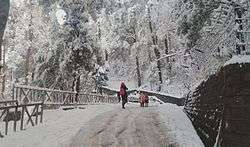 Murree in winter
Murree in winter Dunga Gali
Dunga Gali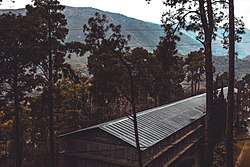
Discovery
- 1 2 The earliest British discovery of Murree, like many of the adjacent hill resorts in the Galyat range of the Hazara region, was first made by Major James Abbott in 1847. Please see Charles Allen Soldier Sahibs: The Men who made the North West Frontier London: Abacus Books, 2001 p. 141, ISBN 0-349-11456-0; and Journals of Honoria Lawrence eds. J.Lawrence and A. Widdiwis, London: Hodder & Stoughton, 1980 edition. For an account of Abbott's early time in Hazara and founding of Abbottabad, see Omer Tarin and SD Najumddin, "Five Early Military Graves in the Old Christian Cemetery, Abbottabad, Pakistan, 1853–1888", in The Kipling Journal (ISSN 0023-1738) Vol 84, No 339, p.35-52
Citations
- ↑ "PROVISIONAL SUMMARY RESULTS OF 6TH POPULATION AND HOUSING CENSUS-2017". Pakistan Bureau of Statistics. Retrieved 21 October 2017.
- ↑ Concise Dictionary of World Place-Names (2012).
- ↑ "A British town in the hills: Book on Murree launched – The Express Tribune". The Express Tribune. 2013-11-12. Retrieved 2016-10-29.
- 1 2 3 4 5 Chisholm (1911).
- ↑ "Murree Culture | Murree History". www.world66.com. Retrieved 2016-10-29.
- ↑ Correspondent, A (2016-07-10). "Rain, tourists cause traffic jams in Murree". DAWN.COM. Retrieved 2016-10-29.
- ↑ "Independence Day: Festivity plans finalised for Murree – The Express Tribune". The Express Tribune. 2014-08-04. Retrieved 2016-10-29.
- ↑ Asghar, Mohammad (2015-08-14). "Pakistanis not free to go to Murree on Independence Day". DAWN.COM. Retrieved 2016-10-29.
- ↑ "Nawaz, Tajikistan President meet in Murree – Pakistan – Dunya News". dunyanews.tv. Retrieved 2016-10-29.
- ↑ "PM House rejects Imran's Murree 'home renovation' claim". Retrieved 2016-10-29.
- 1 2 3 Imperial Gazetteer of India (1909).
- ↑ Lee (2001).
- ↑ World Weather Information Service (2013).
- ↑ "Murree Climate Normals 1961–1990". National Oceanic and Atmospheric Administration. Retrieved January 16, 2013.
- ↑ Murree, Climate. "Murree Snow Fall Season". www.skardu.pk. SKardu.pk. Retrieved 18 February 2017.
References
- Everett-Heath, John (2012). "Murree". Concise Dictionary of World Place-Names (2nd ed.). Oxford University Press. Retrieved 2012-06-20.

- "New Murree project in harmony with environment". Daily Times (Pakistan). 2 August 2005. Retrieved 2012-06-22.
- "Murree, Pakistan". GeoNames. 2007. Retrieved 2013-06-22.
- "Murree Town". Imperial Gazetteer of India. 18. Oxford: Clarendon Press. 1909. p. 42. Retrieved 2013-06-22.
- Lee, Harold (2001). Brothers in the Raj: The Lives of John and Henry Lawrence. Karachi: Oxford University Press. ISBN 0-19-579415-X.
- "World Weather Information Service — Murree". Retrieved 2013-06-22.
- Abbasi, Wajih (26 April 2014). "Political History of Murree". Retrieved 22 June 2014.
External links
| Wikimedia Commons has media related to Murree. |
| Wikivoyage has a travel guide for Murree. |